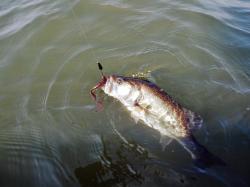Farm ponds and small lakes offer excellent fishing earlier than other waters
Editor’s Note: Today’s feature comes to us from Lee McClellan of the Kentucky DFWR, but the advice applies to farm ponds and small lakes everywhere this spring.
FRANKFORT, Ky. – When air temperatures crest the 70-degree mark for the first time in March, anglers swarm reservoirs and state-owned lakes to fish. The warm weather stirs up high expectations, but these anglers often return home frustrated after a fishless day.
These big waters still retain their winter cold and a few days of shirt-sleeve weather doesn’t warm them up enough to get largemouth bass, bluegill or catfish active. They still feel the lethargy of winter.
Farm ponds and small lakes less than 10 acres are the perfect antidote for this situation. Their small size and relatively shallow waters warm up quicker in spring than large reservoirs sprawling over thousands of acres or state-owned lakes several hundred acres in size.
The extended warm front forecasted for this week is the ideal situation to catch the biggest largemouth bass of the year. “A lot of those largemouth bass are moving up into shallow water with these warm temperatures,” said Jeff Crosby, Central Fisheries District biologist for the Kentucky Department of Fish and Wildlife Resources. “If we get a nice warm rain coming up this week, the water temperatures will jump and it will be ‘katy bar the door’. The big gals are moving up right now. It is going to get hot.”
Three days or more of air temperatures warmer than 70 degrees bring largemouth bass into water two feet deep or less, especially after March rains color the water. They nudge their noses right up on the bank and hide in shoreline cover, small cuts in the bank or even among clumps of shoreline grass that extend out into the lake.
Largemouth bass use objects such as stumps, rocks, grass clumps or fallen tree tops as reference points in muddy water, much as humans use objects to navigate a dark room.
Parallel the bank with a brown and orange shallow-running, square-billed crankbait and retrieve it as slowly as the lure allows. A 4-inch green pumpkin-colored lizard rigged weightless with a 3/0-worm hook and crawled slowly along the bottom is deadly in this situation.
A 1/8- or 3/16-ounce black jig paired with a black and blue trailer also excels as does a 4-inch boot-tailed grub in the pumpkin pepper color. These lures work well in both murky and clear water.
Banks that fall off quickly into deeper water are best for fishing a parallel retrieve for largemouth, with the dam face being the paramount choice on small lakes.
March rains that cloud the water also pull largemouth into shallow waters in coves on small lakes and the upper end of farm ponds. Any isolated cover on the shallow flats should be probed with the jig and trailer combination, the lizard or the grub. Cast on the bank and gently pull the lure into the water to avoid spooking fish.
Stealth is vitally important to fooling largemouth bass in water a foot deep. Walk softly, keep low and wear drab colors, even if the water is muddy. Careless anglers who stomp around the shoreline may notice V-shaped wakes heading off toward deeper water formed by largemouth bass spooked from their shallow lairs. These fish won’t bite again for hours.
Bluegill anglers can find great sport in early spring on farm ponds or small lakes. Water clarity dictates how and where to fish.
Murky to muddy water means anglers should fish small in-line spinners or 1-inch white or yellow curly tailed grubs near any available cover. Many farm ponds are simply gouged out bowls in the ground and have little to no fish holding cover. Simply cover water with these lures until a bluegill strikes.
In clear water, fish redworms near cover either on the bottom or suspended under a bobber, threaded on a No. 6 Aberdeen hook. Bottom fishing works best on bright days.
The new soft baits designed for panfish that broadcast scent work extremely well fished on the bottom or to tip a 1/32-ounce yellow feather jig fished near cover and suspended under a bobber.
Prolific breeders, keeping and eating bluegill benefits the pond or small lake and provides a tasty, nutritious meal as well.
Channel catfish move toward the shallow flats of the upper end of a farm pond or small coves in the section farthest from the dam in a small lake during a March warm front. Rains that tint the water with runoff draw huge numbers of catfish into these spots, gorging on worms flushed into the pond or lake.
Nightcrawlers threaded onto a 4/0 circle hook and bottom fished in these areas can lead to some of the fastest catfish action of the year. Dead minnows, chicken livers or commercial prepared stink baits all work for channels in small lakes and farm ponds in murky water or clear.
The warm winds of March are here. Forgo the big lake and hit a small lake or farm pond instead. Remember, the new fishing license year began March 1 and you must now purchase a new one before fishing in 2016.
By Lee McClellan, Kentucky DFWR, www.fw.ky.gov.
